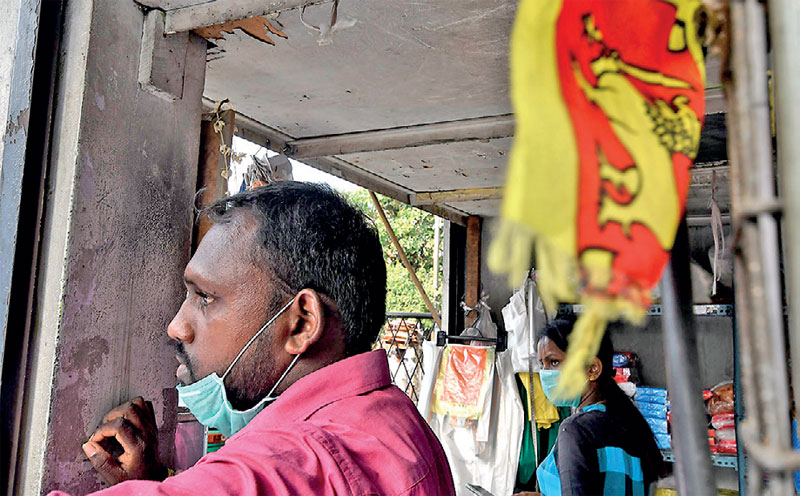Wednesday Jan 14, 2026
Wednesday Jan 14, 2026
Monday, 25 October 2021 00:00 - - {{hitsCtrl.values.hits}}

The advent of COVID-19 created a public health emergency and an economic crisis, causing economic damage and dampening Sri Lanka’s development prospects – Pic by Shehan Gunasekara
Despite facing difficulties in managing the economic impacts of the pandemic, if Sri Lanka can reduce poverty, enable women to join paid work, and control its debt, it will have reason for optimism
 Although Sri Lanka has achieved lower middle income status, its record on economic growth and structural change has continued to disappoint. In November 2019, a new president was elected with an ambitious agenda to transform national security, the economy, and society.
Although Sri Lanka has achieved lower middle income status, its record on economic growth and structural change has continued to disappoint. In November 2019, a new president was elected with an ambitious agenda to transform national security, the economy, and society.
However, the advent of COVID-19 created a public health emergency and an economic crisis, causing economic damage and dampening Sri Lanka’s development prospects.
The first clear impact on Sri Lanka’s economy was a sudden contraction in economic growth. The pandemic and COVID-19 containment measures caused the worst contraction in the Sri Lanka’s post-independence history, with gross domestic product contracting by 3.6%.
The contraction can be attributed to weak performance of the construction, garments, tea, and mining sectors, a two-month island wide lockdown, the closure of the international airport preventing tourism, and weak global demand for the country’s exports.
Second, the country saw a steep rise in poverty. Estimates based on the ‘middle-income poverty line’ of $ 3.20 a day suggest that poverty rates in Sri Lanka increased from 9.2% in 2019 to 11.7% in 2020. This amounts to an additional half a million people in Sri Lanka, largely in urban areas and the informal sector, who are now experiencing poverty due to the pandemic.
This is in part because Sri Lankan industry suffered significant job losses in major sectors, especially in garments, construction and tourism, during the pandemic. Daily wage-earning, informal sector workers, who account for about 70% of the work force, and small enterprises seem the hardest hit.
Third, women’s employment was adversely affected. Female labour force participation rates fell from 34.5% to 32.1% between 2019 and 2020, showing the pandemic led more women to opt out of the workforce than men. This has reversed previous gains in this area.
On top of female workforce participation rates falling and unemployment rates rising, surveys show that women have felt heightened pressure during the pandemic. This comes as a result of having to balance the demands of work – often through shift work or teleworking – while still bearing primary responsibility for unpaid work, such as household chores and home-schooling children.
This has caused exhaustion and mental health issues and was likely a leading factor in some women being forced out of the workforce.
Fourth, Sri Lanka’s already high debt levels rose during the pandemic. In December 2020, the Central Government’s debt-to-GDP ratio rose to 101%. Public expenditure fell as the government scrambled to put in place measures to mitigate the contraction, while revenue generation fell to historic lows due to a reduction in economic activity, job losses, and previous income tax cuts.
The outcome was a steep rise in the fiscal deficit. The country’s typically unfavourable debt dynamics reflect persistent fiscal and current account deficits, notable currency depreciation, the costs of a 30-year civil conflict that ended in 2009, and lacklustre post-conflict growth.
On top of the country’s domestic problems, increasing concerns about the country’s ability to pay back debt have led international ratings agencies to downgrade Sri Lanka’s credit rating.
Interestingly though, the pandemic-induced contraction could be short-lived. Growth picked up to 8% in the first half of 2021, underpinned by strong performance in agriculture and industrial activities, which were broadly able to continue throughout the pandemic, cheap credit, and pent-up consumer demand.
Entering the COVID-19 crisis with weak macroeconomic conditions meant Sri Lanka was only able to put out a muted fiscal stimulus compared to other South Asian economies. Instead, a panoply of other policies were attempted to try and limit the economic fallout from the pandemic, a signature part of which has been an unprecedented easing of monetary policy.
This has included the central bank reducing policy rates to historic lows and lifting caps on private enterprises borrowing money through treasury guarantees. The country has also been relaxing regulatory forbearance rules.
Another measure is stringent import controls to conserve scarce foreign exchange reserves.
To some extent, the unconventional mix of policies adopted by the Government has helped to mitigate the pandemic and support the economy.
However, this is not a long-term solution, and over time it could introduce economic distortions into the fragile economy and impede recovery. For instance, lengthy import controls could encourage rent-seeking behaviour among Sri Lankan businesses and invite retaliation from trading partners. Furthermore, loose monetary policy can lead to upside inflationary pressures affecting the poor through rising food prices.
Risks are also emerging relating to the duration of the third wave of the pandemic, limited tourism arrivals and foreign investment inflows, macroeconomic policy inconsistencies, and tightening global financial conditions.
Unfortunately, significant uncertainty still clouds Sri Lanka’s economic outlook. But, if the country focuses on reducing poverty, returning women to the workforce, and managing its debt levels, there is hope for its post-pandemic future.
(This article can read on https://pathfinderfoundation.org web and Dr. Ganeshan Wignaraja, is Senior Research Associate, Overseas Development Institute, London and Senior Visiting Fellow, Pathfinder Foundation.)